Services on Demand
Article
Indicators
Related links
-
 Cited by Google
Cited by Google -
 Similars in Google
Similars in Google
Share
South African Journal of Education
On-line version ISSN 2076-3433
Print version ISSN 0256-0100
S. Afr. j. educ. vol.30 n.3 Pretoria Jan. 2010
ARTICLES
Sense of belonging and social cohesion in a desegregated former House of Delegates school
Ramodungoane TabaneI; Salome Human-VogelII
Idungoane@gmail.com
IIsalome.humanvogel@up.ac.za
ABSTRACT
The ideal of creating a non-racial and equitable school environment is embedded in the South African Constitution. This ideal is informed by a desire to overcome the divisions of the apartheid past by pursuing policies and strategies that will promote the achievement of social cohesion, without denying space for various identities. Schools are seen as important vehicles for driving social cohesion amongst learners and it is therefore important that all learners, irrespective of their race, experience a sense of belonging in the school. Using a case study and an interactive qualitative analysis research methodology, we explored the experiences of black and Indian learners in a desegregated former House of Delegates school to determine the successes and possible challenges of ensuring racial integration at the school level and therefore its contribution to social cohesion. The study demonstrates the importance of eight concepts (namely, the school as a welcoming space; belonging; respect; security; equality in the way we socialise; tender loving care; motivation; and freedom) to the study of racial integration and social cohesion. This article focuses on the contribution that sense of belonging has on creating a school environment that is enabling, contributing to learner achievement and concludes that sense of belonging, integration, and social cohesion are intertwined and important in creating an environment that is welcoming and a "home" to diverse learners and educators.
Keywords: belonging; desegregation; diversity; integration; Interactive Qualitative Analysis; race; social cohesion
Introduction
There have been a number of reports (Vally & Dalamba, 1999; Sekete, Shibulane & Moila, 2001) which indicate that racial tension in schools continues, despite local and national efforts to promote social cohesion. School desegregation policies provide one means of achieving social cohesion (Nkomo & Vandeyar, 2009; Hurtado, Meader, Ziskin, Kamimura & Greene, 2002), but continuing reports of interracial violence suggest this strategy is not working as well as it could. There have been frequent reports of racial1 discriminationand violence between black and white learners at schools (Christie 1990; Carrim, 1992; Vally & Dalamba, 1999; Machaisa, 2004; Meier, 2005, Phatlane, 2007), and universities (The Citizen, 1997; The Star, 1997; Monare, 1999; The Citizen, 1999; The Citizen, 2000; Cape Argus, 2000; Mboyane, 2000; Molakeng, 2001; Mail & Guardian, 2007; Davids, 2007).
Because there has been a shift from reports of racial altercations in desegregated white schools - as noted by Dolby (2001) - lately learners of different races are brought together by their similar interest and "hangout spots". However, we still have much to learn and we believe important lessons can be learned by studying intra-black integration. Thus, contrary to the acrimony experienced in the black/white school desegregation, the desegregation of black/Indian schools' environment sounds a different tune. A tune that appears to indicate that these two races, relatively speaking, engage harmoniously with each other in the same and shared space. Thus, in this study, we were particularly interested in examining the extent to which learners of different races (black and Indian) are able to negotiate a sense of belonging in a former segregated House of Delegates school. We therefore examined social cohesion in a black/Indian desegregated school environment by focusing on learners' sense of belonging in the school that has become racially and culturally diverse.
Sense of belonging is presented as one dimension of social cohesion that brings and allows individuals to feel as part of, and identify with, the group and contributes to the shared values and aspirations underpinned by need for affirmation, friendships and the need to be part of the group (Menzies & Davidson, 2002; Green et al., 2003; Friedkin, 2004).
Sense of belonging and social cohesion
Various reports (Vally & Dalamba, 1999; Sekete, Shibulane & Moila, 2001) indicate that racial tension in schools is still continuing, despite the constitutional and policy injunctions for equity and equality in social relations. Seeing that education can be one way of achieving social cohesion, it seems appropriate to examine the extent to which the school under study mirrors the constitutional and policy intentions with regard to social cohesion.
There is no clear agreement in the literature on definitions and measurement of social cohesion (Kearns & Forest, 2000; Friedkin, 2004; Chan, To & Chan, 2006). As a construct, social cohesion has received varied attention in an attempt to locate it in different disciplines and its definition, conceptualisation and measurement is still an open debate (Friedkin, 2004; Chan, To & Chan, 2006). According to Friedkin (2004:409) "the main source of confusion is a proliferation of definitions of social cohesion that has proved difficult to combine or reconcile". In agreement, Chan, To and Chan (2006: 273) conclude that the social cohesion concept has been "conceptualised in literature: in many cases, definitions are too loosely made, with a common confusion between content and the cause or effects of social cohesion".
Chan, To and Chan (2006) lament the vague conceptualisation of social cohesion that complicates its measurement and attempt increased clarity by distinguishing between academic and policy discourses. On the other hand, Bollen and Hoyle (1990) argue that it is important that, when studying social cohesion, we should not neglect individual group members' perceptions of their cohesion to the group. This is a problem which Friedkin (2004) acknowledges that it causes difficulty when trying to reconcile individual and group perspectives of social cohesion. To overcome this problem, Bollen and Hoyle (1990) propose the study of perceived cohesion, which focuses on individuals' perception of their cohesion to the group along two dimensions, namely, sense of belonging and feelings of morale. More formally, perceived cohesion is thus defined as "an individual's sense of belonging to a particular group and his or her feelings of morale associated with membership in the group" (Bollen & Hoyle, 1990:482). Thus, they argue for a more subjective approach to the study of cohesion that accommodates the study of factors related to the individual in the group.
An individual plays a major role in the success of a socially cohesive society or school. Therefore, social cohesion is seen in the manner in which an individual is accepted in the same or diverse group. Individuals' perception about their participation and level of acceptance in the group influences their sense of belonging and therefore attitude as members of the group. The member attitude means the individual's "desire or intention to remain in a group, their identification with - or loyalty to - a group or other attitudes about the group members" (Friedkin, 2003:410). Thus, a sense of belonging can develop as a result of alliances with learners who share similar values or identities, despite social structures seemingly prescribing, for instance, a particular sport or music as "belonging" to a certain racial group. Dolby (2001) found that learners associated and befriended each other along their preferred popular culture (for instance, similar music preference) and not so much along the racial lines and therefore creating group dynamics where learners were separated on who was, and who was not, part of the group as a result of personal preferences. Therefore, sense of belonging - as one aspect of social cohesion - can be attained when members feels that other members of the group share similar personal preferences.
Learners who feel as part of the group and have a sense of belonging, are more likely to have a sense of connectedness with other group members. These members are more likely to develop trust in, respect and positive regard for, their fellow members and therefore fostering social cohesion in the group. Friedkin (2003) points out that positive interpersonal relationships are very important to social cohesion in groups. Related to positive interpersonal relationships, Miller (2002:388) says that intimate contact [between different persons and/or racial groups] plays an important role in reducing prejudice. Thus, learners' positive interaction with diverse peers is linked with "increases in cultural knowledge and commitment to promoting racial understanding" (Hurtado, Meader, Ziskin, Kamimura & Greene, 2002:8) and can therefore lead to positive interpersonal relationships that will affect individual members' sense of belonging to a particular group.
Sense of belonging can further be attained - according to Thaver (2004) through experiencing a sense of being 'at home' in a school situation, for instance. Thaver (2004) explains that the critical factor in the distinction between 'home' and feeling 'at home', is in the social relations that are established with other social actors in a given place and which obtain mutual assurances, a sense of fitness and belonging that ultimately generates the feeling of being 'at home'. Therefore, it is possible that feelings of 'at home' can be experienced when an individual has a positive experience in a strange place. Thus, Thaver (2004:6) noted "the question is [not] 'do you feel at home?', but, rather where, and with whom, doing what and to what end, do you feel comfortable enough to be able to say 'I feel at home' or 'in place' in a given institution".
Lastly, at another level, Nkomo and Vandeyar (2009:11) mention that schools, "by and large, mirror society with all its accoutrements and ... are in a unique position to serve as cradles of social innovation to address the tensions and to contribute to greater social cohesion". Indeed, Green, Preston and Sabates (2003) suggested earlier that the promotion of social cohesion through education has re-emerged as an important objective for many countries in the past decade. In South Africa, social cohesion through education finds expression in socio-political policies such as racial integration, equal education and inclusive education strategies. Although inclusive education was initially focused on including learners with special needs, Graham and Slee (2008) argue that the term is expanding and is increasingly including all aspects of diversity. Thus, racial integration policies and inclusive education policies can be argued to share the same aspiration and goals for learners to develop a shared trust and identity through education.
This paper brings together the body of literature on racial integration in South African context and social psychology debates on social cohesion, thus, we hope to contribute to the debate on social cohesion by focusing on the ways people connect, as well as share values and identity to indicate a sense of belonging as one of the constructs that can be used to explain what social cohesion is. It is therefore important for an individual to feel as part of the community and that the community accepts him/her as a member and not only as a visitor. In a school setting, new learners not only aspire to be part of the in-group and certain teams because they want to fulfil their sense of belonging by making new friends who share the same values with them, but they also want to be accepted and respected as individuals. Although there is no single definition of what constitutes social cohesion, it can be seen as the interactions amongst different people that connect them; make them feel that they belong and are part of the group; that their shared experience and connectedness transcend the set social boundaries, structures, cultures or traditions and as individuals, contribute to the well-being of that society, group and community.
The central research question in this study was How do Grade 11 learners negotiate a sense of belonging in a desegregated former House of Delegates school? Furthermore, to examine the research question, two sub-questions were formulated to structure the investigation. Firstly How do Grade 11 learners conceptualise belonging in a desegregated former HoD school? and secondly, How do Grade 11 learners' sense of belonging contributes to social cohesion in the desegregated former HoD school?
Research design and methodology
Data were collected and analysed by means of Interactive Qualitative Analysis (IQA) (Northcutt & McCoy, 2004). As a social constructionist approach to data generation, collection and analysis, IQA addresses power relations between the researcher and participants. Participants are encouraged through various IQA protocols to generate, collect and analyse their own data. IQA is a qualitative research methodology that attempts to provide a systemic, rigorous and accountable framework for qualitative inquiry. It is a suitable design when researchers wish to examine how phenomena are socially constructed and if they wish to develop a theory of the research phenomenon that demonstrates a systemic understanding of the phenomenon (Northcutt & McCoy, 2004).
Research site and context
The study was conducted in a desegregated former House of Delegates (HoD) secondary school after receiving ethical clearance from the University of Pretoria and being granted permission to conduct this research by the Department of Education. Gandhi Secondary School caters for both black and Indian learners and also employs both black and Indian teachers, unlike other desegregated schools where staff demographics do not change with learner demographics (Vally & Dalamba, 1999) or become mono-racial with the increasing numbers of black learner enrolment. This school has recently celebrated its centenary as an Indian school and has a rich Indian culture which is visible from - amongst others - the memorabilia, such as unveiling and some acknowledging granite stones embedded in the walls of the school and practising of Indian religion. The school is situated in a low socio-economic area within an Indian community. Most Indian learners walk to school, while most black learners are transported every morning and picked-up after school by taxis.
Ten participants were randomly selected in Grade 11 (black and Indian learners) to form part of a focus group and eventually participated in individual interviews. Gender was not regarded as a core variable in this study as the focus was on how the group as a constituency negotiates a sense of belonging.
Data collection
Two phases of data collection were conducted. The first phase involved a focus group and the production of a focus visual presentation. The second phase of the study involved individual interviews based on the visual presentation generated by the focus group.
Data analysis
IQA is designed to determine the causal relationship between the affinities (focus group produced eight affinities [Table 1]) through theoretical coding where participants "ascertain the perceived cause-and-effect relationships (influences) among all the affinities in a system" (Northcutt & McCoy, 2004:149).
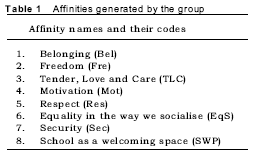
This process unfolds when participants are presented with the opportunity to indicate the directional links between the affinities. Three possible relationships were indicated. Firstly, if A influences B, it is indicated as A B; secondly, if B influences A, it is indicated as A
B; secondly, if B influences A, it is indicated as A B; and lastly, if participants do not think the affinities are related, it is indicated as A<>B. It is important to note that participants are not judging the strength of a relationship, but merely the existence of it (Human-Vogel & Van Petegem, 2008:458). Participants' indications of the relationships are then plotted on an affinity relationship table (ART).
B; and lastly, if participants do not think the affinities are related, it is indicated as A<>B. It is important to note that participants are not judging the strength of a relationship, but merely the existence of it (Human-Vogel & Van Petegem, 2008:458). Participants' indications of the relationships are then plotted on an affinity relationship table (ART).
To determine which relationships to analyse from a pool of possible causal relationships, IQA uses the Pareto principle in the data analysis. The Pareto principle states that 20% of the variables in a system will account for 80% of the total variation in outcome (Northcutt & McCoy, 2004). The Pareto principle is mostly known in an economic context where it refers to the principle that, in an organisation, for example, 80% of the profits will roughly be generated by 20% of the accounts (Human-Vogel & Van Petegem, 2008: 459). On the other hand, the conflicting relationships are those affinities that have arrows in both directions. In such cases, the affinity pair with the highest frequency is included in the rationalisation step.
Creating an Interrelationship Diagram (IRD) (Table 2) is the first step in a general process called rationalizing the system (Northcutt & McCoy, 2004: 170) (Table 3).
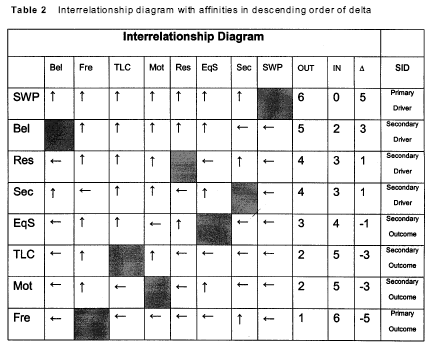
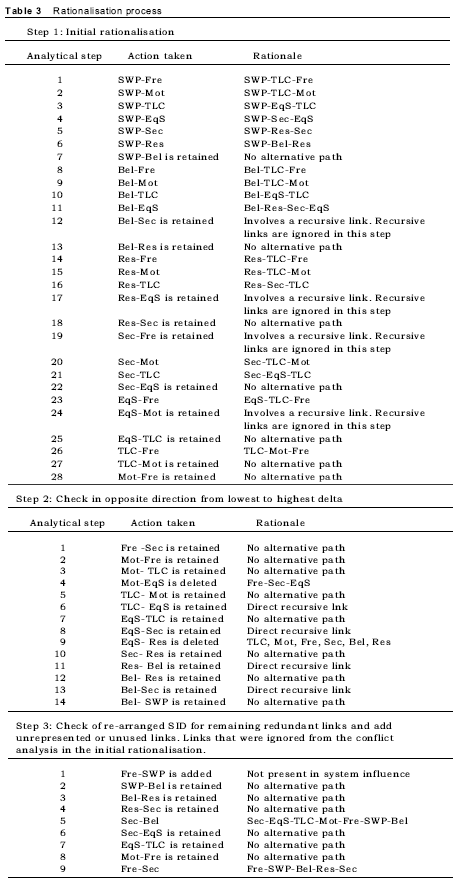
The IRD is a matrix containing all the perceived relationships in the system and it contains a summary of the ART in the form of arrows that show whether each affinity in a pair is perceived to be a cause or an effect, or if there is no relationship between the affinities in the pair. Important to note in the IRD is how the delta value is calculated and what it represents.
Delta values are calculated for each affinity by subtracting the number of arrows facing inward (left) - also called the 'Ins' - from the number of arrows facing outward (up) - also called the 'Outs' - associated with the affinity. The delta value is important in the sense that it is used to assign affinities as either drivers, or pivots or outcomes of the system. The primary driver (a significant cause) affects many other affinities, but is not affected by others. The secondary driver is a relative cause or influence on affinities in the system. The circulators or pivots occur when there are equal numbers of 'Ins' and 'Outs'. The primary outcome (a significant effect) that is caused by many affinities, but does not affect others whilst, the secondary outcome reveals a relative effect. (Northcutt & McCoy, 2004:173-4; Lasserre-Cortez, 2006:77; Human-Vogel & Mahlangu, 2009:42; Human-Vogel & Van Petegem, 2008:458).
Constructs were arranged in order of delta and the relationships for all the construct pairs, as indicated in IRD relationship diagrams, were carried over and depicted visually, resulting in cluttered Systems Influence Diagrams (Human-Vogel & Van Petegem, 2008:463). Table 2 reflects an interrelationship diagram with the affinities arranged in descending order of delta.
In the final phase of the focus group data analysis, affinities were summarised in the Systems Influence Diagram (SID) (Figure 1).
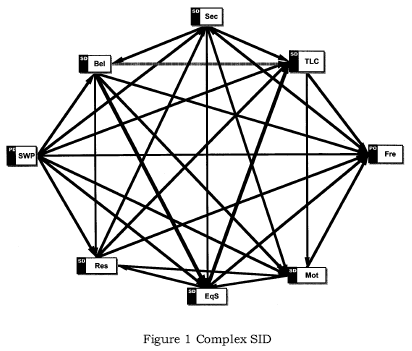
Systems Influence Diagram (SID) is a visual representation of an entire system of influences and outcomes and is created by representing the information present in the IRD as a system of affinities and relationships among them (Northcutt & McCoy, 2004:175). As Lasserre-Cortez (2006) did in her study, boxes were organised, representing each affinity on paper with outcomes on the right and drivers on the left.
Rationalisation process when creating the SID of this study
Rationalisation is, according to Northcutt and McCoy (2004:37), "undertaken to describe the comprehensiveness, complexity, parsimony or simplicity and visual interpretability". The links are created by linking the highest delta to the lowest while the direction of the link (arrow) is determined by the Interrelationship Table (IRD). The purpose of rationalisation is to eliminate redundant links while retaining those that also retain the meaning. To visualise this process, the elimination of redundant links is illustrated in Table 3.
The clean SID shown in Figure 5 was used for Phase Two of the IQA process - in-depth interviews. The interviews primarily served to add depth and individual experience to group-level processes. Thus, Phase Two served to interrogate individual-level negotiation sense of belonging (Bollen & Hoyle, 1990) as well as provide an understanding of the interaction between individual and group level processes in negotiating a sense of belonging (Friedkin, 2003).
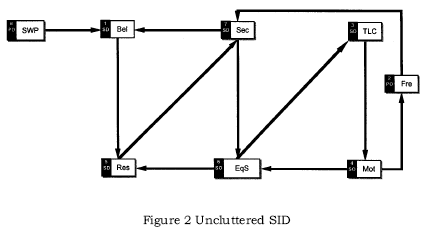
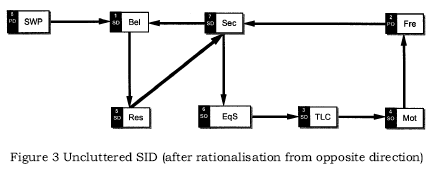
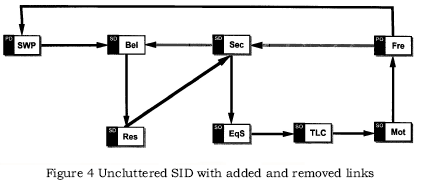
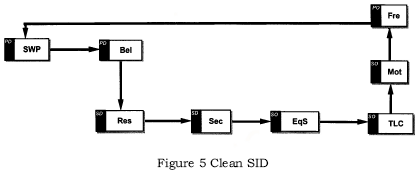
Figure 2 indicates an uncluttered SID. It represents a mind map, containing only the minimum numbers of links required to completely represent the underlying logic of the IRD (Northcutt & McCoy, 2004).
Figure 3 indicates an uncluttered SID, read from the opposite direction.
Results
The focus group generated eight constructs that participants used to generate a theory through inductive and deductive processes. An audit trail of the analytical process was provided to indicate each step in the analysis of the data. The resulting visual presentation (SID) that was created is a representation of the generated theory or 'mental model' of the group (Human-Vogel & Van Petegem, 2008:456) and is provided in Figure 5.
The visual presentation (Figure 5) indicates that the affinities that were identified as primary drivers in the system were school as a welcoming space and belonging. Affinities identified as secondary drivers were respect and security. The secondary outcomes affinities in the system were indicated as equality in the way we socialise, tender-loving-care and motivation. An affinity identified as the primary outcome was identified as freedom.
Discussion, implications and contribution
The visual presentation indicates the importance that participants attach to a responsive environment (school as a welcoming space) that helps to strengthen a personal sense of belonging because it influences interpersonal interactions by fostering respect and equal treatment of one another in a strive towards achieving a socially cohesive society. The social interactions and involving other persons are indicated as noted in the visual presentation by fostering safety, having positive regard towards each other and exercising one's freedom as an individual and as a group member. The combined effects of these affinities influence personal motivation as one aspect of academic achievement and socialisation.
Menzies and Davidson (2002) point out that good enough environment where learners are assisted to move towards authenticity through being known, enables genuine connections with others. Respect, as a driver, refers to learners' respectful treatment of each other and suggests the importance of this study's contribution to the literature on social stigma. In a review of the social psychology of stigma, Major and O'Brien (2005) point out that social stigma contributes to identity threat that has a significant impact on self-esteem, academic achievement and health.
The study focused on the psychological dimension to the topic of racial integration by examining sense of belonging in a school environment as a dimension of social cohesion. Most studies on racial integration tend to focus on the socio-political perspective by highlighting socio-cultural aspects of behaviour, such as popular culture (Dolby, 2001; Dawson, 2003; Nkomo, Chisholm & McKinney, 2004; Tihanyi, 2006). As noted by Chipkin and Ngqulunga (2008), studies focusing on the social fabric in South Africa are scarce and need to be integrated into a host of government programmes and policy. The findings of this study attempt to contribute in this regard by drawing attention to the importance of viewing racial integration not only from a political perspective, but also from a psychological perspective. As such, this study serves to generate specific hypotheses for future research on racial integration and social cohesion by pointing to the relative importance of the role of the school in creating a culture in which all racial groups can feel welcome. Thus, it would be important in future studies to examine the relationship between institutional variables and their effect on social cohesion in terms of individual attitudes and behaviours, as well as group-level factors of cohesion.
Studying a sense of belonging in racially diverse learning environments has some implications for the study of social stigma and the extent to which it influences identity formation and racial integration. People who are stigmatized, are believed to have an attribute that "marks them as different and leads them to be devalued in the eyes of others" (Major & O'Brien, 2005). In South Africa, apartheid policies contributed to the creation of social stigmas related to race. However, whereas an overwhelming number of studies in South Africa focus on the social stigmatization of people in terms of HIV/AIDS, the literature on the systematic examination of racial prejudice and mental health is still nascent. Paluck and Green (2009) note correctly that despite the impressive body of literature in social psychology on the topic of racial prejudice, psychologists are a long way from demonstrating the most effective ways to reduce racial prejudice. This study contributes to the literature on the topic by demonstrating that learners can experience a sense of belonging in racially integrated environments. The affinities generated by the participants urge researchers on racial integration to study more systematically the psychological dimensions of racial integration by focusing on the relationship between school culture and the extent to which it succeeds in valuing the social identities of all races, as well as the association between integration, stigmatisation and its effects on self-esteem, the need for positive regard and prevention of prejudice.
Although this study seems to suggest that racial integration can impact positively on a personal sense of belonging and so contributes to social cohesion, the more significant implication of this study lies in the silence of social cohesion in the black/white integration which reflects the more problematic and complicated relationship between the black and white population in South Africa. Reviewing studies that examine the effect of social rejection, Williams (2007) concludes that chronic exposure to ostracism (such as was experienced by blacks under South African apartheid policies), depletes coping resources and leads to depression and helplessness. We may argue that the children currently in South African schools were born in a free country and thus, theoretically, should not be subject to social ostracism. Although this study did not directly examine important constructs related to social cohesion and belonging, such as social capital and civic engagement (Stolle, Soroka & Johnston, 2008), this study does have relevance in terms of highlighting what the participants in the study value in their engagement with one another. Stolle et al. (2008) make the point that regular and positive social contact mediates the extent to which people tend to trust one another. The findings of this study indicate that positive social contact specifically includes experiencing positive emotions, such as trust, respect, harmony, and joy; thus pointing to the importance of positive affirmation.
Sense of belonging was studied from both the individual and group level indicators of social cohesion. Williams (2007) mentions that belonging is a fundamental requirement for security, reproductive success and mental health. Thus, for an individual to be happy with him/herself and also as a member of the group - a sense of belonging must be fostered because learners who feel ostracised by their peers, or those in authority, will not function optimally. Therefore, the school grounds may be a hub for brewing disintegration in the school's social fabric and social cohesion in general.
As noted, literature (Bollen & Hoyle, 1990: Friedkin, 2003) is not in agreement as to what defines social cohesion.. This study only looked at few aspects, for instance, that of belonging being a vital contributor to social cohesion. However, various possible hypotheses for further studies can be raised as indicated by the Systems Influence Diagram.
Finally, this study points to the importance of appreciating the role that racial identity has on belonging. It offers insights useful to psychologists about assisting learners in racially diverse schools with integration and also mentions the importance and the role of inclusive education. The study further pointed to the importance of positive interpersonal relationships (belonging, respect, tender-loving-care, motivation) and social relationships (school as welcoming space, security, freedom, equality in socialisation) which psychologists have a role in mediating and facilitating.
Acknowledgement
We acknowledge the contribution of Prof Mokubung Nkomo as a co-supervisor of the thesis in this article.
Note
1. We acknowledge that these terms are not used unproblematically and that there are emotions attached to racial identifiers. We are keeping the racial identifiers of the past, i.e. those of blacks, coloureds, Indians and whites, because they have historical significance and we are looking at a school that historically desegregated among black and Indian learners and is now seeking to integrate black and Indian learners.
References
Bollen, KA & Hoyle RH 1990. Perceived cohesion: a conceptual and empirical examination. Social Forces, 69:479-504. [ Links ]
Cape Argus 2000. Race insults end in school fights, 30 August.
Carrim N 1992. Desegregation in coloured and Indian schooling. Johannesburg: University of Witwatersrand. [ Links ]
Carrim N 1998. Anti-racism and the 'new' South Africa educational order. Cambridge Journal of Education, 28:301-320. [ Links ]
Carter PL 2006. Opportunities and paradoxes: An examination of culture, race and group incorporation in post-apartheid South African schools. Paper presented at the Social Cohesion and Diversity Colloquium, Muldersdrift, Gauteng, South Africa. [ Links ]
Chan J, To H & Chan E 2006. Reconstructing social cohesion: developing a definition and analytical framework for empirical research. Social Indicators Research, 75:273-302. [ Links ]
Chipkin I & Ngqulunga B 2008. Friends and family: social cohesion in South Africa. Journal of South African Studies, 31:61-76. [ Links ]
Christie P 1990. The Catholic open schools and social reform. In: M Nkomo (ed.). Pedagogy of domination: Towards a democratic education in South Africa. [ Links ]
Dash S 1988. A case study in microcosm of the voluntary desegregation efforts of a large urban city school's system: An analysis of the L. C. Springwood Elementary School from 1954 to 1984. USA: University of Pennsylvania. [ Links ]
Davids N 2007. Swearing lies at the heart of school violence: Pupils believe that words can lead to sticks and stones. Available at http://0-www.samedia.uovs.ac.za.innopac.up.ac.za/cgi-bin/getpdf?year=2007&refno=4637&topic=25. Accessed 15 July 2008. [ Links ]
Dawson M 2003. Changing context shifting identities. Paper presented at Wits interdisciplinary research seminar,October 2003. Johannesburg, South Africa. [ Links ]
Dolby N 2001. Constructing race: Youth, identity and popular culture in South Africa. Albany: State University of New York Press. [ Links ]
Fife BL 1997. School desegregation in the twenty-first century: The focus must change. Lewiston: The Edwin Mellen Press. [ Links ]
Friedkin NE 2003. Social cohesion. Annual Review Sociology, 30:409-425. [ Links ]
Green A, Preston J & Sabates R 2003. Education, equality and social cohesion: a distributional approach. Compare, 33: 453-470. [ Links ]
Graham LJ & Slee R 2008. An Illusory interiority: interrogating the discourse/s of inclusion. Educational Philosophy and Theory, 40:277-293. [ Links ]
Human-Vogel S & Van Petegem P 2008. Causal judgments of positive mood in relation to self-regulation: A case study with Flemish students. Contemporary Educational Psychology, 33:451-485. [ Links ]
Human-Vogel S & Mahlangu PP 2009. Commitment in academic contexts: First year education students' beliefs about aspects of the self, the lecturer and instruction. South African Journal of Higher Education, 23:309-328. [ Links ]
Hurtado S, Meader EW, Ziskin M, Kamimura M & Greene S 2002. Intergroup relations: Views from different racial/ethnic groups. A paper presented at the Association for Institutional Research Forum, June, Toronto, Ontario. [ Links ]
Jordaan M 2002. This is what I do to Boers who hurt me. Available at http://www.dieburger.com. Accessed 15 July 2008. [ Links ]
Kearns A & Forest R 2000. Social cohesion and multi-level urban governance. Urban Studies, 37:995-1017. [ Links ]
Lasserre-Cortez S 2006. A day In the park: An interactive qualitative analysis of school climate and teacher effectiveness through professional action research collaboratives. Doctoral thesis. Louisiana: Louisiana State University. [ Links ]
Machaisa PR 2004. The experiences of learners in the former white schools. Masters dissertation. University of Pretoria, Pretoria. [ Links ]
Mail & Guardian 2007. Do something about school violence, principal pleads, 31 May.
Major B & O'Brien LT 2005. The social psychology of stigma. Available at arjournals.annualreviews.org. Accessed 09 April 2009. [ Links ]
Mboyane S 2000. Boy suffers perforated eardrum in racist attack. Available at http://www.citypress.co.za. Accessed 15 July 2008 [ Links ]
Meier C 2005. Addressing problems in integrated schools: Student teachers' perceptions regarding viable solutions for learners' academic problems. South African Journal of Education, 25:170-177. [ Links ]
Molakeng S 2001. Racist attack lands grade 9 girl in hospital. Sowetan. Available at http;//www.sowetan.co.za. Accessed 15 July 2008. [ Links ]
Monare M 1999. Parent in race row after pupil (8) 'head-butted'. Available at http://www.pretorianews.co.za. Accessed 15 July 2009. [ Links ]
Nkomo M, Chisholm L & McKinney C (eds) 2004. Reflections on School Integration: Colloquium Proceedings. Cape Town: HSRC Press. [ Links ]
Nkomo M & Vandeyar S (eds) 2009. Thinking diversity, building cohesion: a transnational dialogue. Rozenberg Publishers and UNISA Press. [ Links ]
Northcutt N & McCoy D 2004. Interactive Qualitative Analysis: A systems method for Qualitative Research. California: Sage. [ Links ]
Paluck EL & GDP 2009. Prejudice Reduction: What Works? A Review and Assessment of Research and Practice. Available at arjournals.annualreviews.org. Accessed 09 April 2009. [ Links ]
Phatlane RS 2007. Experiences of diversity in a South African public school. Doctoral thesis. University of Pretoria, Pretoria. [ Links ]
Ranchod JR 1997. Indian and African pupil attitudes to integrated schooling in previously-Segregated Indian schools. Masters dissertation. University of South Africa, Pretoria. [ Links ]
Sekete P, Shibulane M & Moila B 2001. De-racialisation and Migration of learners in South African schools. Pretoria: HSRC Press [ Links ]
Stolle D, Seroka S & Johnston R 2008. When does diversity erode trust? Neighbourhood diversity, interpersonal trust and the mediating effect of social instructions. Political Studies, 56:57-75. [ Links ]
Thaver L 2004. "At home", institutional culture and higher education: some methodological considerations. Unpublished paper. University of Western Cape, Cape Town. [ Links ]
The Citizen 1997. Police probing charges after race clash, 16 May.
The Citizen 1999. Racism in school is prevalent. 30 November.
The Citizen 2000. Probe into racism at Groblersdal school, 21January.
The Star 1997. Black, white pupils in school brawl, 16 May.
Tsopo M 2003. Free State Health Focus Month: Philani Service Excellence Awards. Free State Provincial Government. Available at http://www.polity.org.za/article/tsopo-free-state-health-focus-month-philani-service-excellence-awards-20112003. Accessed 5 September 2009. [ Links ]
Vally S & Dalamba Y 1999. Racism, Racial Integration and Desegregation in South African Public Secondary Schools. Report on the study by South African Human Rights Commission. Johannesburg: SAHRC. [ Links ]
Williams KD 2007. Ostracism. The Annual Review of Psychology. Available at arjournals.annual reviews.org. Accessed 9 April 09. [ Links ]
Zimmerman L 2006. Parents' constructions of the role of the helping professional in learning support. MEd dissertation. University of Pretoria, Pretoria. [ Links ]
Ramodungoane Tabane is an Educational Psychologist in private practice. His research interests are in education, psychology, social cohesion, integration, inclusive education, and policy development.
Salomé Human-Vogel is Senior Lecturer in the Department of Educational Psychology at the University of Pretoria. Her research interests focus on the study of commitment as a self-regulatory process in social and achievement contexts, with a special interest in interactive qualitative analysis as a qualitative research methodology.














